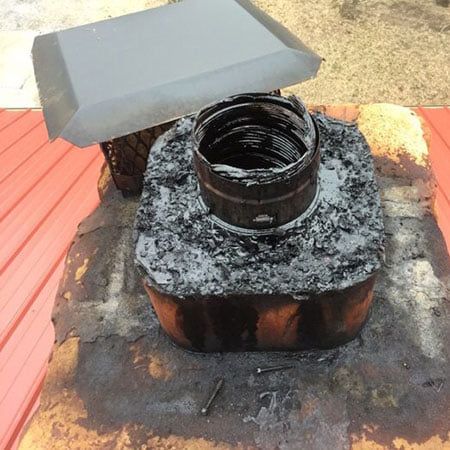If you’re dealing with a damaged chimney flue, there’s no need to worry. We understand the importance of having a functional chimney, and that’s why we’re here to help. In this step-by-step guide, we’ll walk you through the process of repairing your chimney flue and getting it back in great condition. How to repair a chimney flue; From recognizing signs of damage to addressing cracks and replacing tiles, we’ve got all the expert tips and advice you need. With our guidance, you’ll be able to confidently tackle this repair project. So, let’s dive right in and get started!
Key Takeaways: How to Repair a Chimney Flue
- Water damage weakens the mortar and causes leaks, so it is important to address this issue promptly.
- Creosote buildup can increase the risk of chimney fires, so regular cleaning and maintenance are necessary.
- Cracked or damaged flue tiles should be replaced to ensure proper airflow and heat efficiency.
- Regular inspections and preventive measures can help prevent further damage to the chimney flue.
Reasons for Chimney Flue Damage
There are five main reasons for chimney flue damage:
- Water damage: Over time, water can seep into the chimney, weakening the mortar and causing it to crumble. This leads to leaks and further deterioration of the flue.
- Creosote buildup: A corrosive mixture of creosote and moisture can accumulate inside the flue, narrowing the passage and increasing the risk of a chimney fire.
- Storm damage: High winds, falling debris, and heavy rain can cause structural damage to the chimney and the flue.
- Chimney fires: Intense heat from a fire can crack or warp the flue liner, compromising its integrity.
- Thermal stress: Extreme temperature changes can also cause severe damage to the flue.
It is essential to address these issues promptly to maintain the safety and functionality of your chimney.
Signs That a Chimney Flue Needs Fixing
To identify if your chimney flue needs fixing, look for visible signs such as cracks in the brickwork or missing flue tiles. These signs indicate potential damage to the chimney flue, which can compromise its safety and efficiency. Soot accumulation on the chimney is another red flag that should not be ignored, as it can be a sign of a blocked or damaged flue.
Promptly address these issues to prevent further damage and ensure the safety of your home. Seek professional chimney inspections to assess the extent of the damage and determine the best course of action. Regular chimney flue maintenance and preventive measures can also help prevent chimney flue damage.
Methods to Fix a Cracked Chimney Flue
To repair a cracked chimney flue, there are various methods you can use to ensure safety and functionality. One common technique is to replace a single cracked flue tile by carefully removing the damaged tile and installing a new one.
Another method is chimney flue relining, which involves placing an insulated stainless steel alloy tube inside the existing flue to create a more durable lining. Materials needed for this repair may include flue tiles, mortar, stainless steel liners, and insulating blankets made of ceramic wool.
When deciding between DIY and professional repairs, consider the complexity of the repair and your own skills and experience. Avoid common mistakes such as improper measurements for liner size and not removing clay flue tile chimney liners if necessary.
After the chimney flue is repaired, it’s important to perform regular maintenance for its longevity. This can include inspections, cleaning, and using a chimney cap to prevent water damage.
Here is a breakdown of the repair methods and materials:
- Repairing a cracked flue tile: Remove damaged tile and replace with a new one.
- Chimney flue relining: Install an insulated stainless steel alloy tube inside the existing flue.
- Materials needed: Flue tiles, mortar, stainless steel liners, insulating blankets made of ceramic wool.
Considerations for repair:
- DIY vs professional: Consider complexity and your own skills and experience.
- Common mistakes to avoid: Improper measurements for liner size, failure to remove clay flue tile liners if necessary.
Long term maintenance:
- Regular inspections: Ensure ongoing safety and functionality.
- Cleaning: Keep the chimney flue free from debris.
- Chimney cap: Prevent water damage.
Fixing Widespread Flue Crack
To fix a widespread flue crack, follow these steps:
- Inspect the flue tiles for cracks and assess the damage.
- Remove any loose or damaged tiles and replace them with new ones.
- Mix mortar according to the manufacturer’s instructions and apply it to the chimney with a trowel.
- Use a winch and foam to evenly spread the mortar, ensuring it fills gaps and covers the entire surface.
- Pay special attention to filling and sealing tile cracks with mortar.
- Allow the mortar to dry before using the chimney again.
Why Cracked Chimney Flue Is Threatening
A cracked chimney flue poses a significant threat to your home and family’s safety. It is important to prioritize professional chimney flue repair and regular maintenance to avoid potential risks. DIY repairs may lead to further damage and hazards. Here are the dangers of a cracked chimney flue:
- Gas leaks: Carbon monoxide poisoning and health risks.
- Escaping soot and creosote: Fire hazards and property damage.
- Obstructions caused by broken flue tiles: Poor airflow and reduced heat efficiency.
Cracked flue bricks can cause gas leaks that let carbon monoxide enter the house’s interior. Carbon monoxide is described as the “Silent Killer” because it is tasteless, odorless, colorless (invisible), and odorless. As a result, people may pass out if there is no working carbon monoxide detector in the house before realizing there is a threat.
https://verticalchimney.com/blog/how-to-fix-a-cracked-chimney-flue/#:
Ensure the safety of your home and loved ones by addressing chimney flue issues promptly. Don’t let common misconceptions put them at risk.
Inspection and Causes of Damage
When inspecting a chimney flue for damage, look for signs of erosion, cracking, and spalling caused by excessive heat, moisture, and chemicals. Key points to consider include:
- Flue erosion: Over time, mortar joints between clay tiles can erode, creating gaps between tiles.
- Moisture damage: Excessive moisture breaks down mortar, causing deterioration and weakening.
- Spalling causes: Moisture and chemicals react with clay tiles, leading to a rough or pitted appearance.
- Mortar breakdown: Excessive heat and chemicals break down mortar, resulting in spalling.
- Tile cracking: Weather conditions and poor construction can cause clay tiles to crack or break.
Repairing Clay Tiles
To effectively repair clay tiles in your chimney flue, address any damage promptly. You have two options for repairing broken tiles: replace them with new ones or repair the mortar joints. If the damage is limited to the top portion of the flue, you can handle the repair yourself. However, if the damage extends further down the chimney, seek professional help. When replacing tiles, choose ones that are similar in size and shape to the original. Regularly inspect and maintain the chimney to prevent future damage to the clay tiles.
Cast-In-Place Liners
To create a new flue using a cast-in-place method, a professional service inserts an inflatable bladder into the chimney and pumps cement into the space between the bladder and existing flue. Once the cement is dry, the bladder is deflated, leaving behind a solid liner. Cast-in-place liners offer the following benefits:
- Durability: Cast-in-place liners are highly durable and can withstand high temperatures and resist corrosion.
- Longevity: These liners provide a long-lasting solution for chimney flues.
- Cost-effectiveness: Although the initial cost may be higher, the durability and long lifespan make cast-in-place liners a cost-effective option in the long run.
Regular inspections, cleanings, and the use of a chimney cap are recommended to maintain the functionality and protect the liner from debris and weather elements.
Stainless Steel Liners
When repairing a chimney flue, stainless steel liners are a great choice due to their versatility and durability. They come in various shapes and sizes, making them suitable for different chimney flue configurations. The installation process is straightforward, and kits are available that include insulation, fittings, and hookups. Although stainless steel liners may be more expensive than other options, their longevity and resistance to corrosion and creosote buildup make them a worthwhile investment. Overall, stainless steel liners offer superior performance and longevity for chimney flue repair.
Overall Considerations
Before repairing your chimney flue, consider the following:
- Professional inspection is highly recommended to detect hidden defects using specialized equipment like video cameras.
- This inspection ensures all necessary repairs are addressed, reducing the risk of further damage or safety hazards.
Regular maintenance is crucial for a clean and properly functioning chimney flue, as it removes creosote buildup and identifies small issues before they escalate.
Common causes of flue damage include cracks from venting combustion byproducts and exposure to high heat during chimney fires.
Prioritize professional inspection and regular maintenance to prevent common causes of flue damage. DIY repairs may have long-term effects if not done correctly.
Frequently Asked Questions
How Much Does It Cost to Repair a Chimney Flue?
The cost of chimney flue repair varies depending on the type of damage. DIY repair can save money, but it’s important to use the right materials. Signs of a damaged chimney flue include cracks or leaks.
Can I Repair a Chimney Flue Myself or Should I Hire a Professional?
Repairing a chimney flue yourself is possible, but hiring a professional is crucial. Common chimney flue problems can be complex, and professionals have the necessary tools and expertise to handle them safely.
How Long Does It Take to Repair a Cracked Chimney Flue?
To repair a cracked chimney flue yourself, gather the necessary materials and assess the extent of the damage. Regular chimney flue maintenance can help identify signs of cracks early, minimizing repair time.
Are There Any Temporary Fixes for a Cracked Chimney Flue?
If you have a cracked chimney flue, you can try temporary solutions. Using chimney flue sealants is a DIY option that provides quick fixes. However, it’s always recommended to seek professional advice for long-term repairs.
Can I Still Use My Fireplace While the Chimney Flue Is Being Repaired?
While your chimney flue is being repaired, it is not safe to use your fireplace. Follow safety precautions and explore alternative heating options. Look out for signs of a faulty chimney flue and consider DIY repair tips.












One thought on “How to Repair a Chimney Flue: Step-By-Step Guide”